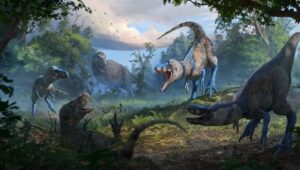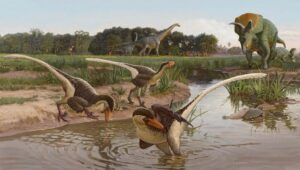Dominated by dinosaurs, the Cretaceous Period was a stressful time for mammals. Researchers assumed that those early mammals were mere prey for the giant saurians. But a new fossil discovery shows that this may not always have been the case. Some of these early mammals successfully preyed on the normally dominant reptiles.
The 125-million-year-old fossil is a perfectly preserved snapshot of an actual fight to the death. It shows a small, badger-like mammal fighting with a juvenile bipedal dinosaur. The mammal has clambered up onto the plant-eating dinosaur and sunk its teeth into the dinosaur’s ribs. In the midst of the fight, a volcanic mudflow engulfed the combatants. The two animals were buried alive, and the scene was frozen in time.

Illustration showing Repenomamus robustus attacking Psittacosaurus lujiatunensis 125 million years ago. Image: Michael Skrepnick
The mammal was the attacker
The fossil turned up in China in 2012. The cat-sized mammal is a Repenomamus robustus, and its victim is a Psittacosaurus lujiatunensis. Their relative sizes suggest that neither animal was fully grown, and the positioning suggests that the mammal was the instigator.
“The lack of bite marks on the dinosaur skeleton, the position of the mammal atop the dinosaur, and the grasping and biting actions of the mammal, collectively signal that the mammal was preying on the weakened dinosaur when the two were suddenly entombed by a volcanic debris flow,” said the research team.
This is the second fossil of a Repenomamus robustus that suggests that early mammals were not simply a food source. In 2005, another fossil of the small mammal was found in a nearby Chinese location. Astonishingly, it had the remains of a young Psittacosaurus inside its stomach.
The Repenomamus robustus was 18.5 inches long. Today, this would make it quite a small species, but in that early era, it would have been one of the largest mammals on the planet. By contrast, the dinosaur was 120cm long. Though larger than the mammal, it was still a relatively small dinosaur.

An artist’s drawing of the two species during their battle.
As the dinosaur here was a herbivore, researchers believe that the small mammal actually started the fight.
“The two animals are locked in mortal combat, intimately intertwined,” said paleobiologist and study co-author Jordan Mallon. “It’s among the first evidence to show actual predatory behavior by a mammal on a dinosaur.”
They first thought that the mammal was scavenging from an already dead dinosaur, but closer inspection showed that this was not the case. The dinosaur’s bones are in place, and there are no bite marks that coincide with the scavenging patterns that you would expect.
But is it genuine?
To preempt questions about whether the fossil is a fake, the authors point out that this is highly unlikely. The fossils of the two animals are completely entwined, which would be incredibly hard to forge.
Still, paleontologist Steve Brusatte told The Guardian that he still has some qualms about the research. There have been doctored fossils from this part of the world before, and the scientists did not dig up this specimen themselves.
“The skeletons are no doubt genuine, but I suppose the poses of the bones could have been altered, although I have no direct evidence for this,” he said.






